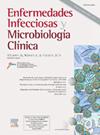Secular trends in periprosthetic joint infections following primary hip and knee arthroplasties: A 15-year cohort study from the VINCat Program (2008–2022)
IF 2.5
4区 医学
Q3 INFECTIOUS DISEASES
Enfermedades infecciosas y microbiologia clinica
Pub Date : 2025-04-21
DOI:10.1016/j.eimc.2025.02.007
引用次数: 0
Abstract
Background
The VINCat program, established in Catalonia, Spain, in 2006, is a comprehensive infection prevention program for healthcare-associated infections. This study aims to analyze long-term trends in periprosthetic joint infections (PJI) following primary hip and knee arthroplasties over 15-year period (2008–2022).
Methods
PJI was defined according to CDC-NHSN criteria and updated in 2016 to incorporate the Musculoskeletal Infection Society classification. Data on PJI following total hip arthroplasty (THA), total knee arthroplasty (TKA), and hip hemiarthroplasty (HHA) were prospectively collected and analyzed across three periods: 2008–2012, 2013–2017, and 2018–2022.
Results
Sixty-seven hospitals participated in the surveillance, reporting 189,063 procedures, including 61,267 THA (median age: 69 years, 47% female), 115,940 TKA (median age: 73 years, 68% female), and 11,856 HHA (median age: 86 years, 73% females). PJI incidence rates for THA were 0.9%, 1.1%, and 1.2% across the three periods (odds ratio (OR):1.14, 95% CI: 0.96–1.35). For TKA, rates were 0.9%, 1.0%, and 0.9% (OR:0.95, 95% CI: 0.83–1.09). The incidence of HHA-PJI declined from 3.4% to 2.3% and 1.8% (OR:0.77, 95% CI:0.58–1.03). Overall, the most common etiology was coagulase negative staphylococci followed by Staphylococcus aureus. PJIs were diagnosed after hospital discharge in 87.1% of THA, 89.6% of TKA, and 73.9% of HHA.
Conclusions
The incidence of PJI remains low despite an aging population undergoing orthopedic surgery, highlighting the effectiveness of current infection prevention strategies. A robust, long-term surveillance system is crucial for monitoring epidemiological trends and guiding the implementation of evidence-based preventive measures.
原发性髋关节和膝关节置换术后假体周围关节感染的长期趋势:一项来自VINCat项目的15年队列研究(2008-2022)
VINCat项目于2006年在西班牙加泰罗尼亚成立,是一个针对医疗保健相关感染的综合感染预防项目。本研究旨在分析15年间(2008-2022年)原发性髋关节和膝关节置换术后假体周围关节感染(PJI)的长期趋势。方法spji根据CDC-NHSN标准定义,并于2016年更新纳入肌肉骨骼感染学会分类。前瞻性收集和分析2008-2012年、2013-2017年和2018-2022年三个时期全髋关节置换术(THA)、全膝关节置换术(TKA)和髋关节半置换术(HHA)后PJI的数据。结果67家医院参与监测,共报告手术189063例,其中全髋关节置换术61267例(中位年龄69岁,女性47%),全髋关节置换术115940例(中位年龄73岁,女性68%),HHA 11856例(中位年龄86岁,女性73%)。三个时期THA的PJI发生率分别为0.9%、1.1%和1.2%(优势比(OR):1.14, 95% CI: 0.96-1.35)。TKA的发生率分别为0.9%、1.0%和0.9% (OR:0.95, 95% CI: 0.83-1.09)。ha - pji的发生率从3.4%下降到2.3%和1.8% (OR:0.77, 95% CI: 0.58-1.03)。总的来说,最常见的病因是凝固酶阴性葡萄球菌,其次是金黄色葡萄球菌。全髋关节置换术中有87.1%、全髋关节置换术中有89.6%、全髋关节置换术中有73.9%的患者在出院后被诊断为PJIs。结论尽管骨科手术人口老龄化,但PJI的发生率仍然很低,突出了当前感染预防策略的有效性。一个强有力的长期监测系统对于监测流行病学趋势和指导实施循证预防措施至关重要。
本文章由计算机程序翻译,如有差异,请以英文原文为准。
求助全文
约1分钟内获得全文
求助全文
来源期刊
CiteScore
2.10
自引率
8.00%
发文量
194
审稿时长
29 days
期刊介绍:
Hoy está universalmente reconocida la renovada y creciente importancia de la patología infecciosa: aparición de nuevos agentes patógenos, de cepas resistentes, de procesos con expresión clínica hasta ahora desconocida, de cuadros de una gran complejidad. Paralelamente, la Microbiología y la Infectología Clínicas han experimentado un gran desarrollo como respuesta al reto planteado por la actual patología infecciosa. Enfermedades Infecciosas y Microbiología Clínica es la Publicación Oficial de la Sociedad Española SEIMC. Cumple con la garantía científica de esta Sociedad, la doble función de difundir trabajos de investigación, tanto clínicos como microbiológicos, referidos a la patología infecciosa, y contribuye a la formación continuada de los interesados en aquella patología mediante artículos orientados a ese fin y elaborados por autores de la mayor calificación invitados por la revista.

 求助内容:
求助内容: 应助结果提醒方式:
应助结果提醒方式:


